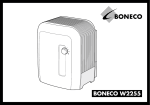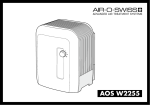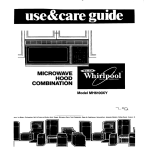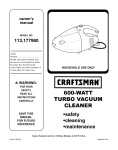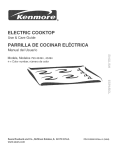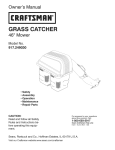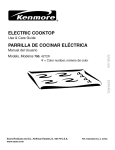Download Craftsman 320.17559 Product manual
Transcript
Product Manual Sander Model No, 320.17559 = Warranty ° Safety . Assembly • Operation , Maintenance = Parts List CAUTION! Before using this product, read this manual and follow all its Safety Rules and Operating Instructions= Sears, Roebuck www,craftsman.com 2340018000 and Co,, Hoffman Estates, IL 60179 Warranty Page 2 Safety instruction Page 3 Assembly Operation . Instructions Page 8 Page 8 Maintenance Page 13 Parts List Page 14 ONE YEAR FULL WARRANTY ON CRAFTSMAN ®PRODUCT tf this Craftsman tool fails to give complete satisfaction within one year from the date of purchase, return it to any Sears store or other Craftsman outlet in the United States for free replacement. This warranty does not include sandpaper, which is an expendable that can wear out from normal use within the warranty period. This warranty applies for only 90 days from the date of purchase product is ever used for commercial or rental purposes. part if this This warranty gives you specific legal rights, and you may also have other rights, which vary from state to state, Sears, Roebuck and Co., Hoffman Estates, IL 60179 Carton Contents Sander, 3 sanding belts, filter, dust-collecting box, manual WARNING: Some dust created by using power tools contains chemicals known to the state of California to cause cancer and birth defects or other reproductive SAVE THESE harm. INSTRUCTIONS! READ ALL INSTRUCTIONS! 17559 Manual_Revised_07-0131 Page 2 SAFETY SYMBOLS The purpose of safety symbols is to attract your attention to possible dangers. The safety symbols and the explanations that accompany them deserve your careful attention and understanding. The safety warnings DO NOT, by themselves, eliminate any danger. They are no substitutes for proper accident-prevention measures. ,_k SAFETY-ALERT used in conjunction ,_ DANGER: SYMBOL: Indicates danger, warning, or caution. May be with other symbols or pictographs. Failure to obey a safety warning will result in serious injury to yourself or to others. Always follow the safety precautions fire, electric shock, and personal injury. _. WARNING, to reduce the risk of Failure to obey a safety warning can result in serious injury to yourself or to others. Always follow the safety precautions fire, electric shock, and personal injury. to reduce the risk of _, CAUTION: Failure to obey a safety warning may result in property damage or personal injury to yourself or to others. Always follow the safety precautions to reduce the risk of fire, electric shock, and personal injury'. DAMAGE PREVENTION AND INFORMATION MESSAGES These inform the user of import information and/or instructions that could lead to equipment or other property damage if they are not followed. Each message is preceded by the word "NOTE," as in the example below: NOTE: Equipment and/or property damage not followed. WARNING: manual tions before may result BE SURE to read and understand using this 6.0 Amp in electric may result if these instructions are shock, Belt Sander. fire and/or all instructions Failure serious to follow personal in this all instrucinjury. WORK AREA SAFETY = KEEP THE WORK AREA CLEAN AND WELL LIT. Cluttered areas invite accidents. benches and dark ,, DON'T USE IN A DANGEROUS ENVIRONMENT. Don't use power tools in damp or wet locations or expose them to rain. Don't operate power tools in potentially explosive environments, such as in the presence of flammable liquids, gases, or dust. Power tools create sparks, which may ignite the dust or fumes. ,, KEEP CHILDREN AND BYSTANDERS distance away from the work area. AWAY. All visitors should be kept a safe • USE THE RIGHT TOOL. Don't force a tool or attachment it was not designed. ° MAKE THE WORKSHOP removing starter keys. 17559 ManuaLRevised_07_131 KID-PROOF with padlocks, to do a job for which master switches, or by Page 3 ELECTRICAL SAFETY o DO NOT CHANGE THE PLUG IN ANY WAY. This belt sander is a double-insulated tool. Double-insulated tools are equipped with a polarized plug (one blade is wider than the other). This plug witi fit in a polarized outlet only one way. If the plug cannot be fully inserted into the outlet, reverse the plug, and try again. If it still does not fit, contact a qualified electrician to install the proper outlet. o VOLTAGE: Before plugging in the tool, make sure that the outlet voltage is within the voltage marked on the tool's data plate. o DO NOT USE "AC ONLY" RATED TOOLS WiTH A DC POWER SUPPLY. o DO NOT EXPOSE POWER TOOLS TO RAIN OR WET CONDITIONS. entering a power tool will increase the risk of electric shock. Water o If operating the power tool in damp locations is unavoidable, always use a Ground Fault Circuit Interrupter to supply power to your tool. Always wear electrician's rubber gloves and footwear in damp conditions. o DO NOT ABUSE THE CORD. Never use the cord to carry the tools or to pull the plug from the outlet. Keep the cord away from heat, oil, sharp edges, or moving parts. Replace damaged cords immediately. Damaged cords increase the risk of electric shock° o USE THE PROPER EXTENSION CORD. 1o Make sure that your extension cord is in good condition. 2. When using an extension cord, be sure to use one heavy enough to carry the current your product will draw. An Undersized cord will cause a drop on line voltage resulting in loss of power and overheating. 3. Table A shows the correct size to use depending on cord length and ampere rating. If in doubt, use the next heavier gauge: the smaller the gauge number, the heavier the cord. 4. When operating a power tool outside, ALWAYS use an outdoor extension cord marked "W-A" or "We" These cords are rated for outdoor use and reduce the risk of electric shock. Volts 120v Ampere Rating Total Length of Cord in feet 25ft 50ft 100ft 150ft More Than Not More Than 0 6 18 16 16 14 6 10 18 16 14 12 10 12 16 16 14 12 12 16 14 12 17559 Manual_Revised_07-0131 AWG Not Recommended Page 4 The label on your tool may include the following v Volts A Amperes Rz Hertz W Watts Minutes rain Alternating current no No-load speed [] Class II construction RPM A symbols; Revolutions or Strokes per minute Indicates danger, warning or caution, it means attention! Your safety is involved. PERSONAL SAFETY • STAY ALERT, WATCH WHAT YOU ARE DOING, and USE COMMON SENSE when operating a power toolo DO NOT use the tool while tired or under the influence of drugs, alcohol, or medication. o WEAR PROPER APPAREL. Do not wear loose clothing, gloves, neckties, rings, bracelets, or other jewelry. Pull back and secure long hair. Non-slip footwear is recommended. ° Keep your hair, clothing, and gloves away from moving parts. o REMOVE ADJUSTING KEYS OR WRENCHES. Form a habit of checking to see that keys and adjusting wrenches are removed from the tool before turning it on. • ALWAYS USE SAFETY GLASSES. Everyday glasses may have impact-resistant lenses, but they are NOT safety glasses. Also use a face or dust mask, if the operation is dusty. TOOL USE AND CARE = AVOID ACCIDENTAL STARTING. Be sure the switch is in the "Off" position before plugging the tool into an electrical outlet. , DO NOT CARRY TOOLS WITH YOUR FINGER ON THE SWITCH. , SECURE YOUR WORK. Use clamps or other practical ways to secure and support the work piece. It's safer than using your hand, and it frees both hands to operate the tool. ,, DO NOT OVER REACH. Keep proper footing and balance at all times. ,, PLACE WORKPIECE ON A WORKTABLE OR WORKBENCH: sturdy table designed for woodworking and similar tasks. a strong and o USE A BACKSTOP: a stable surface against which the work piece may be held, to prevent the work from moving with the sanding belto 17559 ManuaLRevised_0743131 Page 5 TOOL USE AND CARE continued = DO NOT FORCE THE TOOL. Use the correct toot and blade for your application. The correct tool and blade will do the job better and more safely at the rate for which it is designed. . DO NOT USE TOOL IF THE SWITCH DOES NOT TURN IT "ON" OR "OFR" Any tool that cannot be controlled with the switch is dangerous and must be repaired. o DISCONNECT THE TOOL before servicing (such as cleaning the dust-collector box), changing accessories (such as sand paper), or storing the tool. o STORE IDLE TOOLS OUT OF THE REACH OF CHILDREN and other untrained people, • NEVER LEAVE THE TOOL RUNNING UNATTENDED; turn the power off. Don't leave the tool until it comes to a complete stop. _,ALWAYS MAINTAIN TOOLS WITH CARE. Keep cutting tools sharp and clean. Properly maintained tools with sharp cutting edges are less likely to bind and are easier to control. e CHECK FOR DAMAGED PARTS. Before further use of the tool, a guard or other part that is damaged should be carefully checked to determine that it will operate properly and perform its intended function. Check for alignment of moving parts, binding of moving parts, mounting, and any other conditions that may affect its operation. A guard or other part that is damaged should be properly repaired or replaced. WARNING: Use of accessories this tool may create hazardous that are not recommended for use with conditions, USE RECOMMENDED ACCESSORIES, Consult the product manual for recommended accessories. The use of improper accessories may increase the risk of personal injury. SERVICE SAFETY • tf any part of this belt sander is missing or should break, bend, or fail in any way; or should any electrical component fail to perform properly: ALWAYS shut off the power switch and remove the plug from the power source, and have the missing, damaged, or failed part replaced BEFORE resuming operation. , All service that requires opening the tool MUST be performed only by a Sears Service Center. All of the motor parts are important components of the doubleinsulation system and MUST only be serviced by a Sears Service Center. Service performed by unqualified personnel could result in a risk of injury. ,, When servicing a tool, ALWAYS use only identical replacement parts. Follow instructions in the Maintenance Section of this manual. Use of unauthorized parts or failure to follow Maintenance shock or injury. 17559 ManuaLRevised_0743131 Instructions may create a risk of electric Page 6 SPECIFIC SAFETY RULES FOR BELT SANDER _k WARNING: Empty the dust-collecting canister frequently, especially when sanding resin-coated surfaces, such as polyurethane, varnish, shellac, etc. Fine particles of sanding dust may self-ignite and cause fire. ° Hold the tool by the insulated, gripping surfaces whenever performing any operation where the tool may contact hidden wiring or its own cord. Contact with a "live" wire will make exposed metal parts of the tool "live" and will shock the operator. o Always wear safety goggles and a dust mask when sanding, especially sanding over-head. o A suitable breathing respirator pressure-treated objects. must be worn while sanding when chemically- ,,The belt sander is not suitable for wet sanding. o Do not use larger sanding paper than is needed. This tool uses 3" x 18" sanding belts. Extra paper extending beyond the sanding pad can cause serious lacerations. _h, WARNING! Use of this tool can generate dust containing chemicals known to cause cancer, birth defects, or other reproductive harm. Some examples of these chemicals are: o Lead from lead-based o Crystalline paints. silica from bricks, cement, and other masonry products. o Arsenic and chromium from chemically treated lumber. Your risk from these exposures varies, depending upon how often you do this type of work. To reduce your exposure to these chemicals: o Work in a well-ventilated area. o Work with approved safety equipment, such as those dust masks that are specially designed to filter out microscopic particles. Avoid prolonged contact with dust from power sanding, sawing, grinding, drilling, and other construction activities. Wear protective clothing and wash exposed areas with soap and water. Allowing dust to get into your mouth or eyes or to lie on the skin may promote absorption of harmful chemicals. IMPORTANT! 17559 Manual READ ALL INSTRUCTIONS Revised_07-O131 Page 7 Your Belt Sander has been shipped fully assembled, except for the sanding belts and dust-collecting box, which are included in the carton. Inspect the tool carefully to make sure that no breakage or damage has occurred during shipping, if any parts are damaged or missing, return the Belt Sander to any Sears store or other Craftsman outlet in the United States to have it replaced. Please see the Operations section of the product manual for instructions installing the sanding belt and dust-collecting box. WARNING! for If any parts are missing, DO NOT operate this tool until the missing parts are replaced. _1_ WARNING! Your Belt Sander should NEVER be connected to the power source when you are assembling parts, making adjustments, removing belt, cleaning, or when it is not in use. installing or Before attempting to use any tool, always learn about all of the operating features and safety instructions. Fig. 1 Lock-on button Front handle Dust-exhaust Belt-tracking / _ Rear handle port knob ord \ Live-wire indicator ON/OFF Trigger switch Dust-collecting box :Lock lever 17559 ManuaLRevised_07-0131 Page 8 Input: Square Feet Per Minute 120V, 60HZ, AC only, 6 Amps ............................ 1000 SFPM Sanding belt size 3"X 18" Protection II ..... TURN class ON/OFF THE BELT SANDER 1. Connect the plug to an electrical outlet. ,,, , ,,,,,,,,, , ,,,,, (Fig. 2) Fig° 2 2. Start the tool by squeezing the on/off trigger switch. 3. Release the trigger to stop the toolo 4. The lock-on button allows the operator to keep the belt sander running without continuously holding the trigger switch° While squeezing the trigger switch, depress the red lock-on button, then release both the switch and the lock-on button, 5. To release the lock-on button, squeeze and release the trigger switch. NOTE: The trigger cannot be released if you are pressing the lock-on button. WARNING: DO NOT let familiarity careless. Remember that a careless cause severe injury. 17559 ManuaLRevised_07-0131 with your belt sander make you fraction of a second is sufficient to Page 9 TO iNSTALL SANDING BELT _I_ WARNING: Always disconnect attaching 1. Place side, lever front or removing a sanding the sander on its and pull the lock out and Lrd the of the tool. the plug from the power source before belt. t Fig. 3 1 2o Insert the new sanding belt around both rollers. Make sure that the arrow on the inside of the sanding belt points in the same direction as the arrow indicated on the sander. (Fig. 3) 3. Center the sanding belt over the rollers and the bottom plate, then push the lock lever back to its original position to return tension to the belt. ADJUSTING THE BELT TRACKING When a new sanding belt is installed, the sanding belt tracking may need to be adjusted several times as the belt becomes more pliable with use. When the sanding belt tracking is correct, the sanding belt will remain centered on the rollers during use. (Fig. 4) Fig. 4 !. Hold the belt sander upside down, and turn it on. NOTE: This position is for the purpose of adjustment only. Do not allow the sanding belt to come into contact with a work piece or any other object during adjustment. 2. If the sanding belt runs inward toward the belt4ightening belt-tightening knob clockwise. 3, If the sanding belt runs toward 17559 ManuaLRevised_0743131 the outside, rotate the knob knob, rotate the counterclockwise. Page 10 DUST-COLLECTING BOX Your belt sander is supplied with a dust-collecting box. Use it for removing dust: from the sanding space to help keep the working area clear. ,, Before sanding, attach the dust-collecting box to the sander, Fig. 5 Dust-Exhaust Port ,, For longer periods of use, or on large pieces of work, it is advisable to use a suitable vacuum cleaner° Attach a 1-1/4-inch wet/dry-vac hose to the dust-exhaust port. • It is advisable to also wear a suitable dust mask, as there may be residual airborne dust particles in the area. oTo install: Align the dust-exhaust port with the dust-collecting Push the box onto tool until it is firmly seated. (Fig. 5) ,, To remove: Grip the dust-collecting box outlet. box firmly, and pull it out from the tool. _, WARNING: Clean the dust-collecting box approximately every 5 minutes or when dust escapes from the vent of the dust-collecting box, • Clean the dust filter: Open the cover (A) on top of dust-collecting box, and remove the filter (B). Gently tap the filter to remove the dust, or use a soft brush. The filter may then be rinsed with water (no soap), if desired, and allowed to air-dry. (Fig. 6) Fig. 6 Cover (A) Filter (B) Dust-collecting box 17559 ManuaLRevised_07-0131 Page 11 THE LIVE-TOOL iNDICATOR Fig. 7 The Belt Sander has two livetool indicator lamps (Fig. 7). When the tool is plugged into an electrical supply, the livetool indicators will show green lights to remind you that the tool is plugged in, When the tool is unplugged, the lights will turn off. GENERAL SANDING WARNING: Finish sanding can produce clouds of fine, sanding dust that could ignite in the presence of sparks or an open flame. To avoid injury, always use your sander in a well-ventilated area, away from sparks and flames. • Secure the work piece with clamps while sanding. or other means to keep it from moving • Be sure the cord is clear of the sanding belt. , Grasp the handles firmly: Hold the front handle with your left hand and the rear handle with your right hand. o Start the sander off of the work surface to avoid gouging. NEVER start or stop the sander with the belt in contact with the work surface. ° Place the "heel" of the sander on the work first. And then, with a slight forward motion, begin the sanding stroke as you lower the tool onto the work surface. = Use the front handle to guide the sander the sander. o Use short, overlapping the work surface. and the rear handle to control strokes, moving the sander slowly back and forth across ° Do not apply pressure to the sander. The sander is correctly weighted to provide the correct pressure, Too much pressure will slow the work by overloading the motor and reducing the belt speed, Use coarser sandpaper for heavy sanding; do not use increased pressure. a Avoid tilting or rocking the sander or sanding in one spot for too long, This will result in an uneven surface. = Begin sanding with a coarse-grit sandpaper, and gradually use finer and finer grits, until the desired finish is achieved. Do not switch from a coarse grit to a very fine grit in only one step. • To stop, lift the lock-on a complete "run away," the belt sander from the work surface before turning it off. Disengage button and release the trigger switch. Allow the sander to come to stop before setting it down. A moving belt will cause the sander to even if the motor is off. 17559 ManuaLRevised_07-0131 Page 12 _k WARNING! DO NOT at any time allow brake fluids, gasoline, petroleum- based products, penetrating oils, etc. to come in contact with plastic parts. They contain chemicals that can damage, weaken, or destroy plastic. o Before cleaning or performing any maintenance, has been disconnected from the power supply. o Keep all ventilation openings make sure that the belt sander clean. o When servicing a too!, use only identical replacement parts. Follow instructions in the maintenance section of this manual. Use of unauthorized parts or failure to follow maintenance instructions may create a risk of electrical shock and/or serious personnel injury. o All service that requires opening the belt sander MUST be performed only by a Sears Service Center. All motor parts constitute important parts of the doubleinsulation system and MUST only be serviced by a Sears Service Center. Service performed by unqualified personnel could result in a risk of inju_. e Avoid using solvents when cleaning plastic parts. Most plastics can be damaged by commercial solvents. Use clean cloths to remove dirt, carbon dust, etc. 17559 Manual_Revised 0743131 Page 13 The Model Number will be found on the cover of this manual, Always mention the Model Number in all correspondence regarding your tool, 01. 2740234000 Stator 1 02. 2750824000 Rotor 1 03, 2800026000 Brush Holder 2 04. 3120234000 , Cord Anchorage 05. 3120398000 .1 Front Pulley ................ • 1 ,, ,,, ,,,,,,,, ,,,,,,,, ,,,,,,,,,, | ,,,,, 06° 3121011000 Cord Guard 07, 3121034000 Timing Belt 08, 3121036000 Rubber Bushing 09. 3121049000 Rubber Spring 1 '10. 3122975000 Left Housing 1 11. 3122976000 Belt Cover 1 12. 31 22977000 Fan Baffle 1 13. 31 22978000 Mounting 14. 31 23002000 Right Indictor Cover 1 15. 31 23003000 Left Indictor Cover 1 16. 3123004000 Lever 1 17, 3!23006000 Left Rubber Gasket 1 .................. Cover ,,, , , ,, ,, 1 , ,,,,,,,,,,,,,,,,,_.......... 18. 3123007000 Right Rubber Gasket t 19. 3123008000 Dust-Collecting Box Cover I 20. 3123009000 Dust-Collecting Box 1 3320411000 Right Housing 1 21. ,,,,, 1 .... ,,,,,,, 22. 3320412000 Middle Housing 1 23. 3320423000 Filter Assembly 1 24. 3402156000 Adjusting 1 25, 3420508000 Mounting 1 26. 3420102000 Small Belt Pulley 1 27. 3420101000 Large Belt Pulley 1 28. 3420525000 Rear Pulley 1 29. 3520032000 Gear 1 30, 3550143000 Front Pulley Shaft 1 17559 Manual Revised_07©131 Knob Page 14 31, 3550144000 ,,, | .... ,,,,, ,,,,,,, __ Rear Pulley Shaft 1 : 32, 3550145000 Gear Shaft 1 33. 2822072000 Support Assembly 1 34. 3660291000 Spring 1 35. 3660130000 Spring 1 36. 3700138000 Mounting 37. 3700145000 WasherA 38. 3700183000 Washer C 39. 3700249000 Washer 40, 3700487000 Epoxy 41. 2822222000 Belt-Contml 42, 4540017000 Power-Supply 43, 4870313000 Switch i, 1 Plate 1 1 2 Board Assembly Indicator 1 1 1 ,, ,, ,,,,........ ,, 44. 4930004000 Connector 1 45. 4960010000 Carbon Brush 2 46, 5610006000 Tapping Screw 4 47. 5610024000 Tapping Screw 4 48. 5610049000 Tapping Screw 49. 5610103000 Tapping Screw 2 50, 5610106000 Tapping Screw 8 51o 5610034000 Tapping Screw 1 Tapping Screw 8 .... 52. ,,, ,,,,,,,,,,,,,,,,,,, ,,,,, 5610035000 .... 53, 5610037000 54. 5650048000 55, 5650049000 _, i , , • ,, ,, ,,,,,,,,, Thread-Forming , Screw ,,, ,,,.... i,, ,,,,,,,,,,,,,,,,,,, _ Wave Washer 1 Plain Washer 3 Plain Washer 1 _ _.. 56. 5650050000 57, 5660029000 E Ring 1 58, 5680017000 Rivet 1 59, 5700004000 Bail Bearing 1 60. 5700005000 Ball Bearing 3 61, 5700031000 Needle Bearing 4 , 62. 4860006000 Inner Wire 63, 4810002000 Power Cord & Plug ManuaLRevised_07-0131 L, I ,,,,,,' ',,,' ,,, ,,,, ,,,, ,,,,,,,,,,,,,,,,,,, ................................... 17559 , 2 ,,,,, 6 Page 15 12 45 20 4O 23 26 46 9 7 48 1 !7 10 ,_ 22 24 50 18 29 27 31 25 59 8 54 32 28 30 34 13 %7 17559 Manual_Revised_07-0131 Page 17 1"[559 ManuaLRevised_07_)131 Page 18 17559 Manual_Revised_07-0131 Page 19 Get/t f=xed, atyour homeo • : 111 . In ...... :.•i• :-:• • ••• • ••• •• • • ' •: oUrs! r Your Home . < For repairlawn in your and garden no matter home -of equipment, who made all major brand appliances, or heating and cooling systems, it, no matter who sold it! For the replacement parts, accessories and owner's manuals that you need to do-it-yourself. For Sears and items professional like garage installation of home appliances door openers and water heaters. 1-800-4-MY-HOME (i-800-469-4663) www.sears.com _ Anytime, dayor night (U.S.A. and Canada) www.sears.ca Our Home For repair of carry-in products like vacuums, lawn equipment, and electronics, call or go on-line for the nearest Sears Parts & Repair Service Center 1-800-488-1222 Anytime, day or night (U.S.A. only) wv._.sears.com To purchase a protection agreement (UoS.A_) or maintenance agreement (Canada) on a product serviced by Sears: 1-800-827-6655 (u.sA) 1-800-361-6665 Para pedir servicio de reparaciSn a domicilio, y para ordenar piezas: 1-888-SU-HOGAR ® (14_qa4,e427) (Canada) Au Canada pour service en fran_;ais: 1.800-LE.FOYER Mc (1_.6937) www.sears ca SealrS © Bears Brands, LLC @ Registered Trademark t TM Trademark ® Marca Registrada Mc Marque t sM Service Mark of Sears Brands, LLC 1_rMMarca de F&brica / sM Marca de Servtcio de Sears Brands, LLC de commerce ! _DMarqued_pos_e de Sears Brands, LLC





















